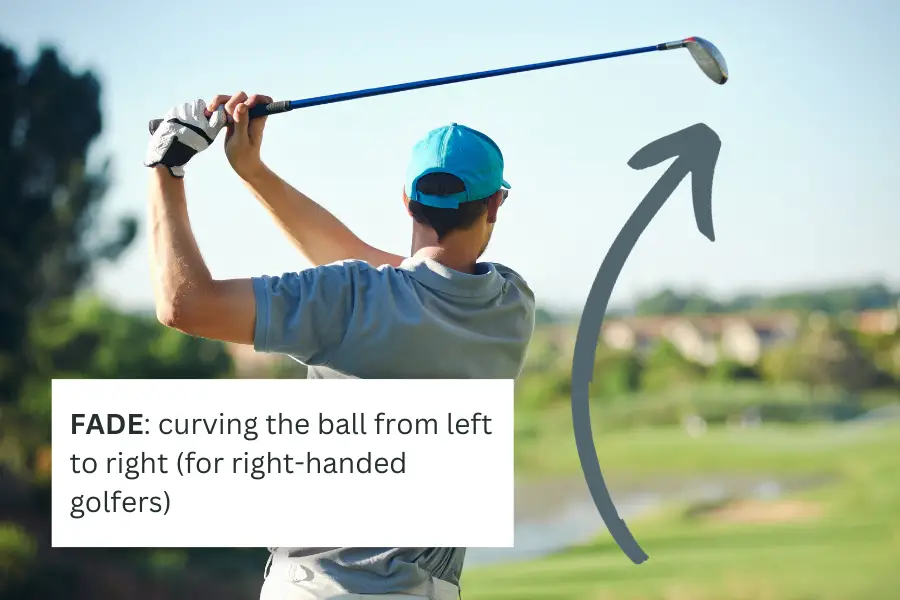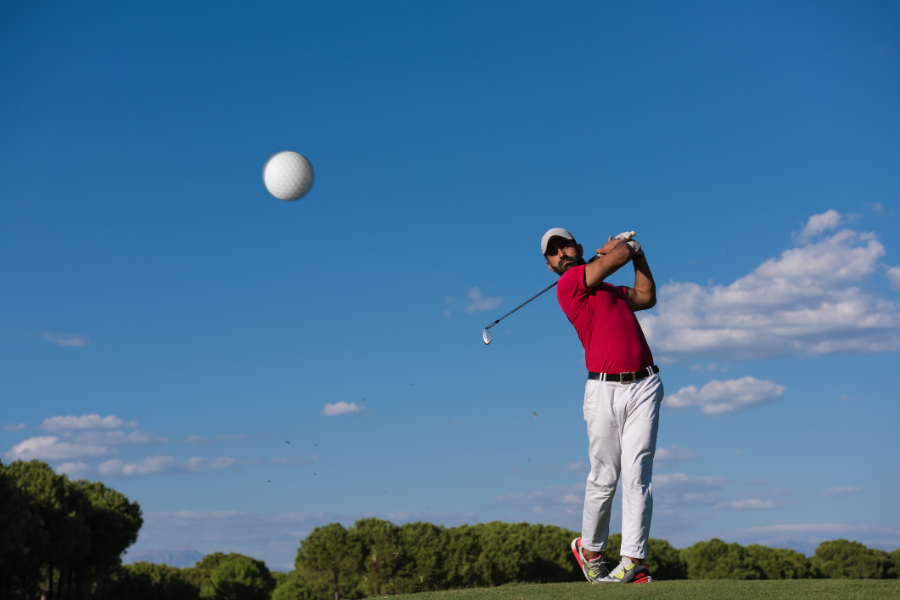If you’ve ever wondered what exactly a fade is or how to master this technique, you’ve come to the right place. As a beginner, these seemingly difficult golf shots can be confusing. However, with proper knowledge and technique, you can use them to shape perfect shots.
A fade shot in golf is a shot that starts out heading straight toward the target but gently curves from left to right (for right-handed golfers, and vice versa for left-handed golfers). It’s like making a gentle arc in the air with your club, adding an element of finesse to your game. But why is it considered difficult? That’s because the fade requires a delicate balance of clubface control, swing path, and body alignment which is quite hard to achieve.

Throughout this guide, I’ll go through the intricacies of the fade shot, providing you with step-by-step instructions, valuable tips, and expert insights. We’ll explore the essential techniques, including grip adjustments, body alignment, swing path, and the release of the club head. We’ll also cover common mistakes to avoid. So let’s get into it.
What Is a Fade In Golf?
Before trying to execute it, let’s answer the valuable question of what is a fade in golf.
The basic concept of a fade in golf involves intentionally curving the ball from left to right (for right-handed golfers) or right to left (for left-handed golfers) during its flight. With the help of this controlled technique, you can shape your shots and navigate around obstacles easily.

A beginner might wonder, is it really that necessary to learn? Well, if you think you’re just fine without learning the fade shot, you’re at fault, my friend. The shot-shaping capabilities of a fade will surely amaze you. It will allow you to avoid hurdles such as trees or hazards and precisely position shots on dogleg holes. Learning what a fade shot is can improve your overall scoring potential to a great extent.
Why Do Golfers Want To Hit A Fade?
From Tiger Woods to Rory McIlroy, you must have seen your favorite golf masters hit fades in tournaments. Let’s dive into why golfers want to hit a fade and explore both the benefits and challenges associated with this shot:
One of the primary reasons golfers aim to hit a fade is the shot’s shaping flexibility. It is beneficial when crossing hurdles, or positioning shots on dogleg holes. The ability to shape shots allows you to find optimal landing positions, and avoid trouble areas.
Another advantage of hitting a fade is its potential to combat crosswinds effectively. In certain wind conditions, a fade shot can help you counteract the wind’s influence and maintain better control over the ball’s flight.
Some golfers naturally prefer hitting fades due to their playing style or personal preference. Each golfer has their own unique swing and shot shape that feels most comfortable and suits their game.
While the fade offers numerous benefits, it also presents challenges that golfers must navigate. Achieving a consistent fade requires precise clubface control, proper swing path, and body alignment. Balancing these elements and maintaining shot consistency can be a challenge and may require dedicated practice and adjustments to find the ideal fade shape.
The common mistakes you should not be doing
When attempting to hit a fade shot in golf, it’s important to be aware of common mistakes that can hinder your success. Here are some common mistakes to avoid when trying to hit a fade.
- While a slightly open clubface is desired for a fade, too much openness can lead to slices or shots that curve too far to the right.
- Aligning too far to the left can lead to shots that push out to the right instead of gently curving.
- While a fade requires a slightly outside-in path, swinging too far from the outside can result in slices or pulls.
- Insufficient body rotation can limit your ability to execute a successful fade shot. Practice adding in a smooth and controlled body rotation to enhance your fade shots.
Easiest guide: How to Hit the Fade in Golf
After going through the basic concepts and benefits associated with the fade, now, it’s time to get your hands dirty in the course. Hitting the fade is a bit more tricky for me than hitting the draw shot, but if I can do it anyway, you can too. However, before that, I would recommend watching this video guide by Eric Chong about hitting the Fade and Draw so that you’ll have a clear picture and imagination when reading this guide further.
Step 1 – Align Your Body
Align your feet, hips, and shoulders further to the left than the clubface. This opens up the clubface in relation to your swing path, causing the ball to spin from left to right.
Step 2 – Adjust Your Grip
Proceed by weakening your grip slightly. If you’re right-handed, move your grip a bit to the left. Make sure your left-hand knuckles are not visible on your grip, but your right-hand knuckles are. Be careful not to overdo it, as too much adjustment can turn your fade into a slice.
🚩 Recommended: Check out the best grips for beginners
Step 3 – Maintain Hand Position
Keep your left hand on top of your right hand for as long as possible during the swing. This helps square the clubface to your release path or even keep it slightly open. Aim slightly left of the target with your feet and shoulders to ensure your fade stays on track.
Step 4 – Swing along Your Alignment
Swing the club along the line of your feet, hips, and shoulders. This starts the ball out to the left and allows the open clubface to curve it back to the right, creating the fade.
Step 5 – Hit with an Open Face
When making an impact, strike the ball so that the toe of the club is tilted slightly backward, and the heel is in front of the toe. This promotes the desired left-to-right movement of a fade. Avoid over-swinging and focus on a smooth, controlled swing to prevent turning the fade into a slice.
Step 6 – Tee the Ball Low
Tee the ball at a lower height and position the center of the ball in line with the driver. This setup allows you to swing more level at impact, helping you achieve a consistent fade.
🏌️♂️ Also Check Out: Why hitting Draw is better than Fade shot?
Conclusion

In conclusion, mastering the fade shot in golf can provide you with valuable shot-shaping abilities and strategic advantages on the course. While it may take practice and adjustments to perfect, the ability to control the left-to-right ball movement can elevate your game and help you overcome obstacles with ease.
You may also use simulators to practice regardless of weather and time to be on your top game. Keep practicing, stay patient, and embrace the challenge of mastering the fade.
FAQs
Q) Why is draw better than fade?
A) Draws are preferred over fades for two main reasons: wind penetration and increased distance. Draws have lower spin, allowing them to cut through the wind more effectively and maintain a stable flight path. Additionally, the flatter trajectory of draws results in increased distance covered.
Q) What are the ball flight laws?
A) The ball flight laws in golf explain how the clubface angle and swing path influence the direction and curvature of the ball. The clubface angle at impact determines the initial direction, while the swing path determines the curvature. Understanding these laws helps golfers analyze and adjust their swing mechanics to control the ball’s flight path.
Q) How do I adjust my setup and swing to achieve a fade in golf?
A) To achieve a fade in golf:
- Weaken your grip slightly.
- Align your body slightly left of the target.
- Position the clubface slightly open at the address.
- Swing along your body’s alignment, starting the ball out to the left.
- Maintain a smooth and controlled swing.
Jabez is the guy who started this blog with Bryan. He’s been playing golf since a young age and has a lot of experience to share. But more importantly, Jabez is someone who is always looking to help others out. He’s got a great sense of humor and is always up for a good laugh. But most importantly, Jabez is someone who cares about his followers and always wants to help them improve their game. For any queries reach out to him at Jabez@iamlearninghowtogolf.com.
